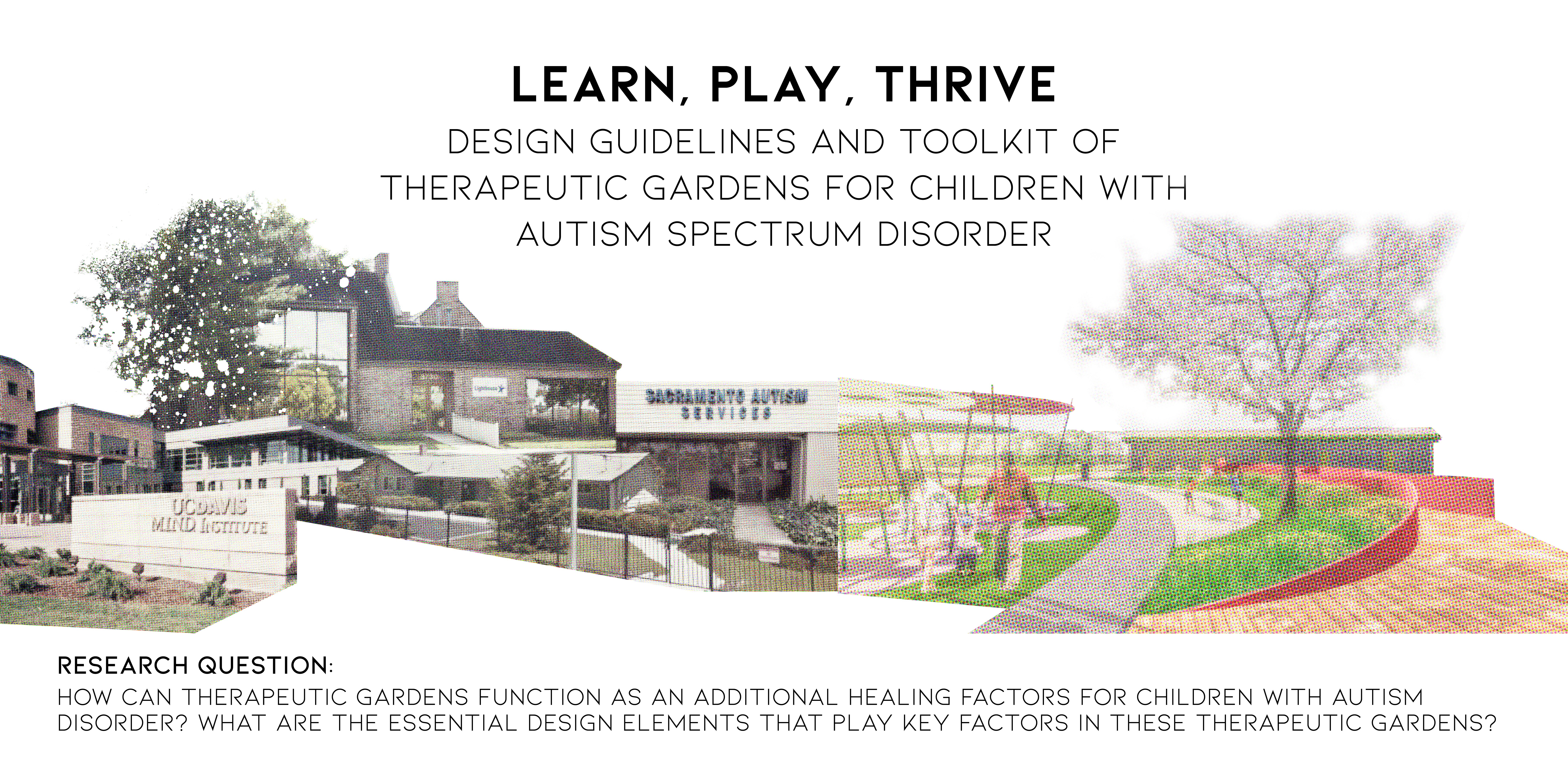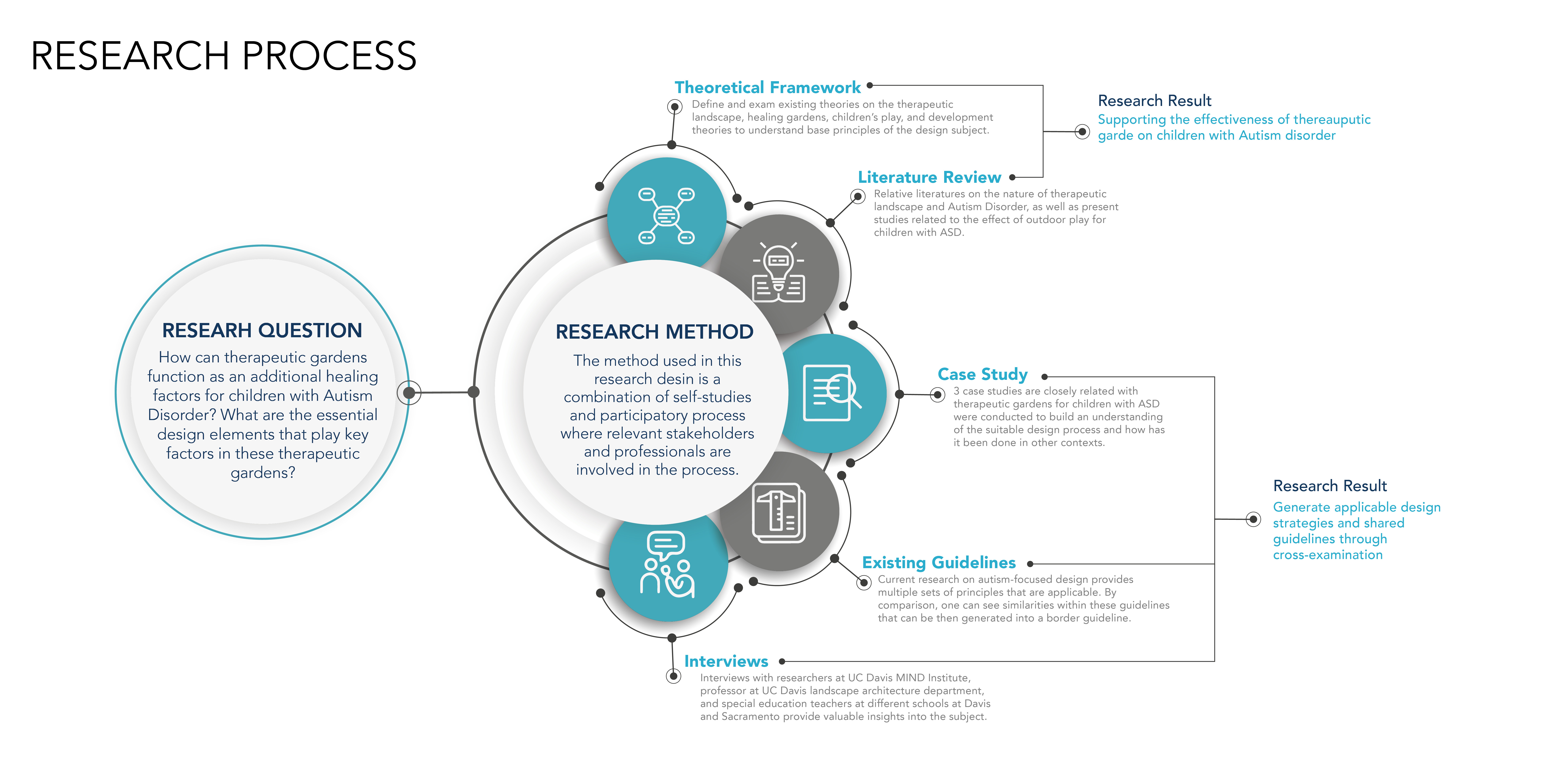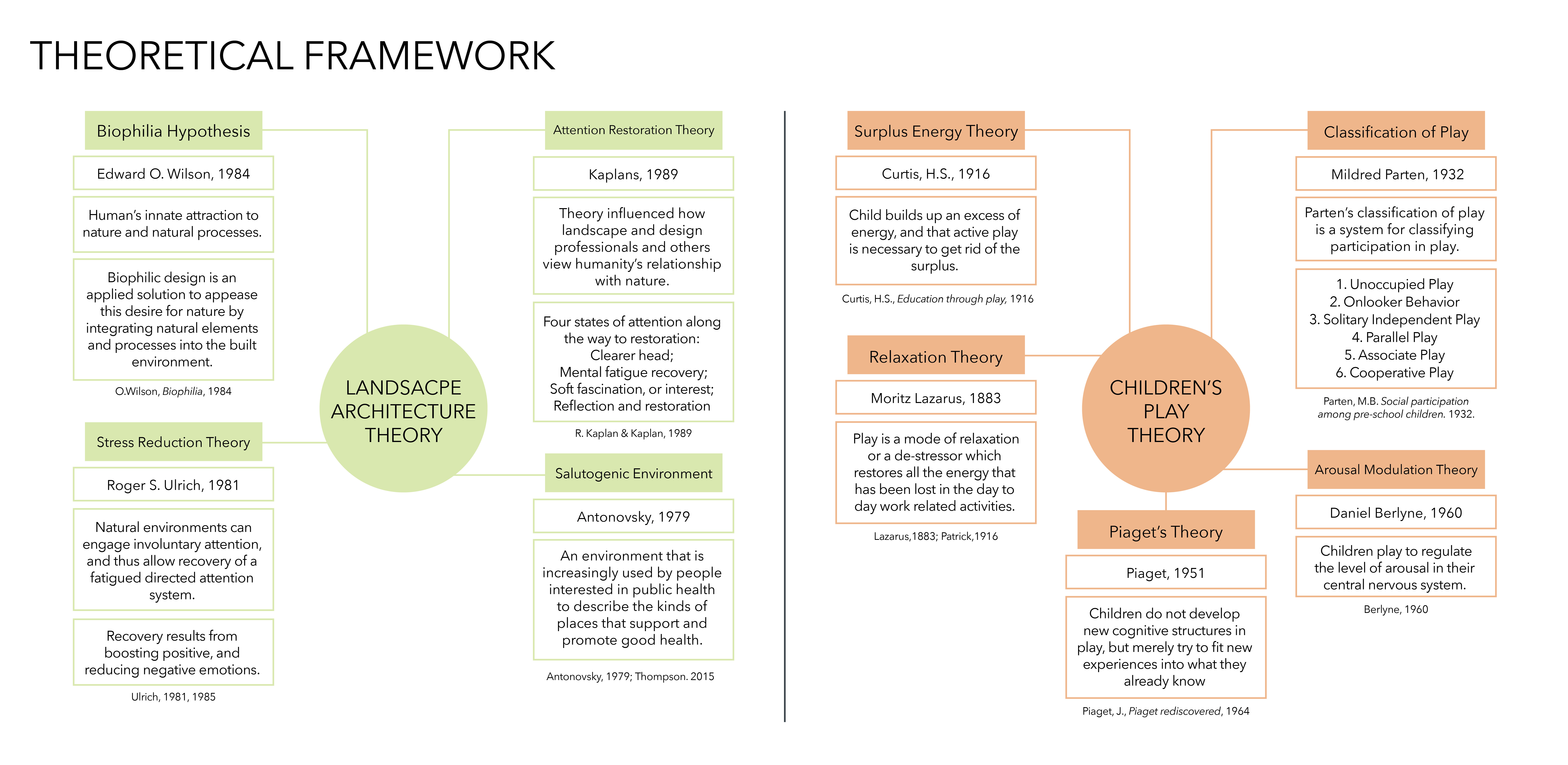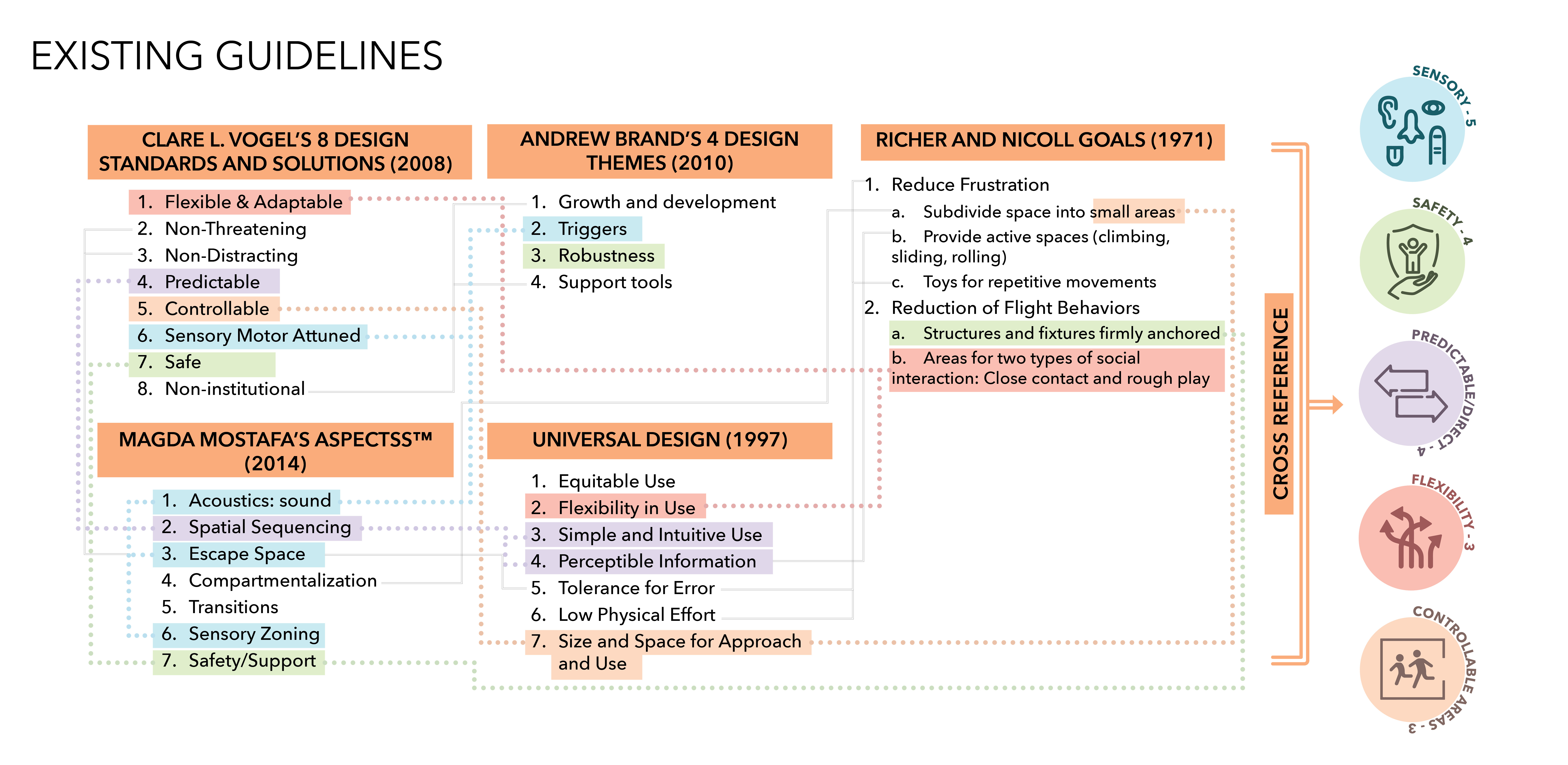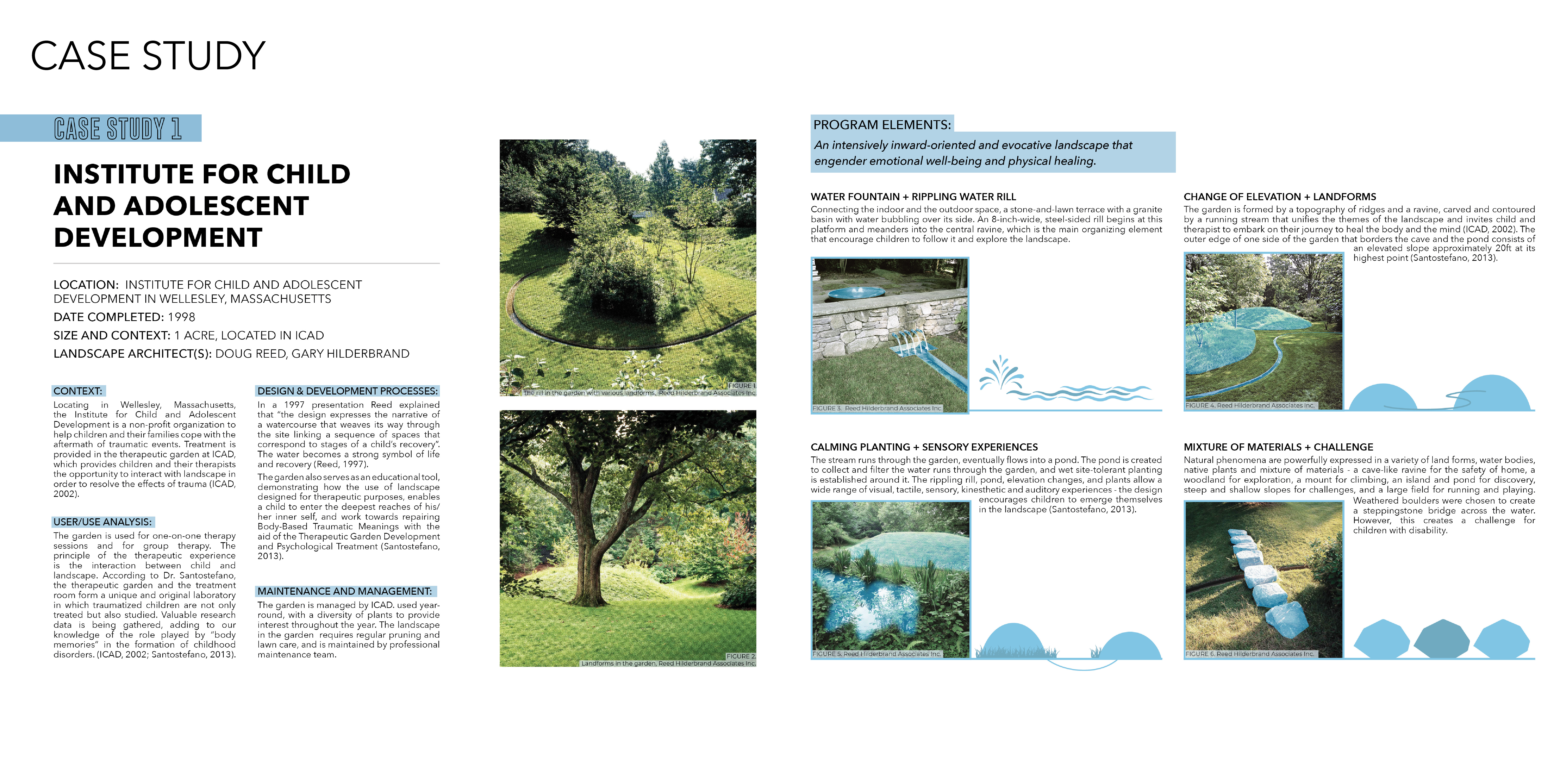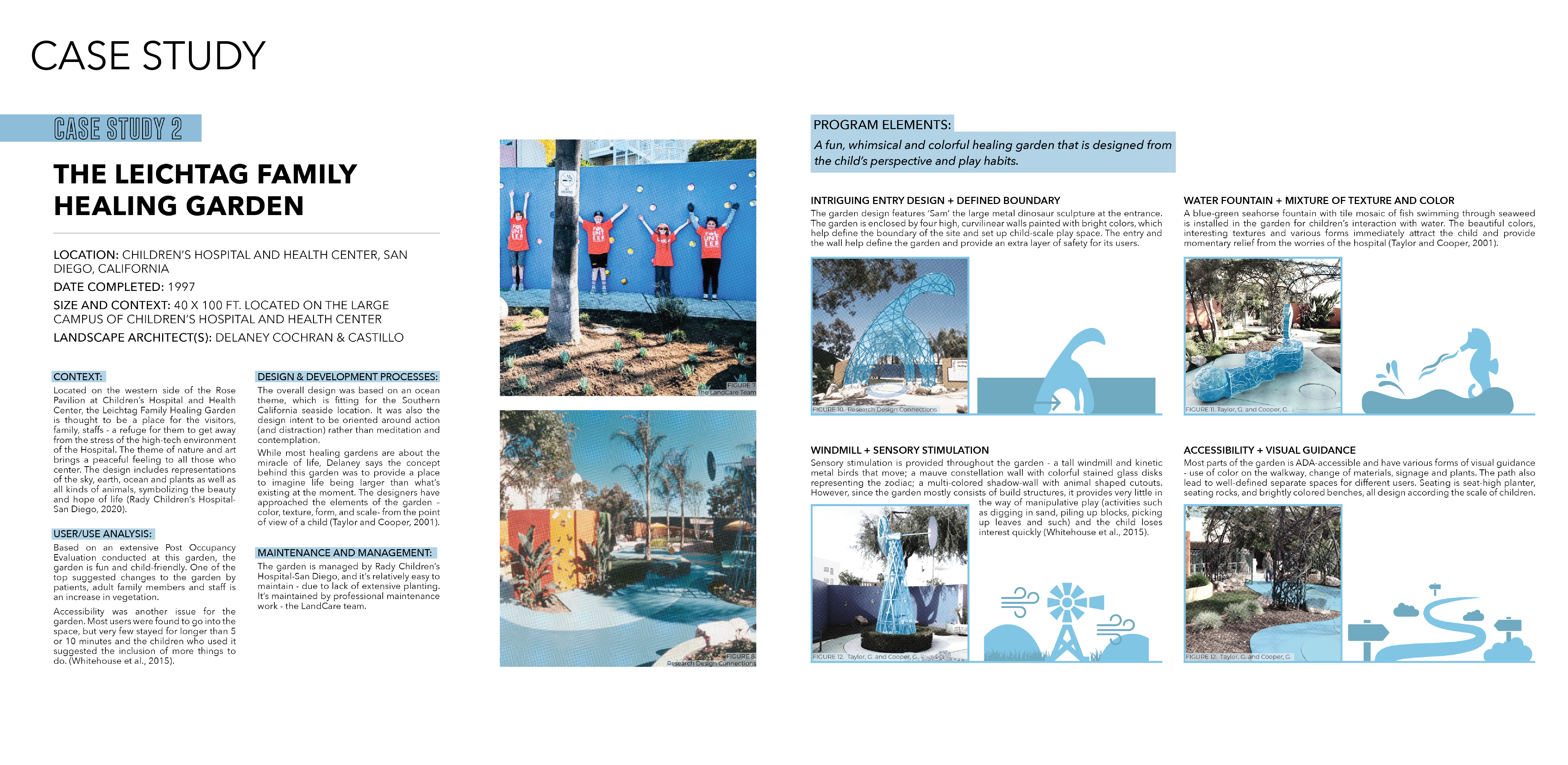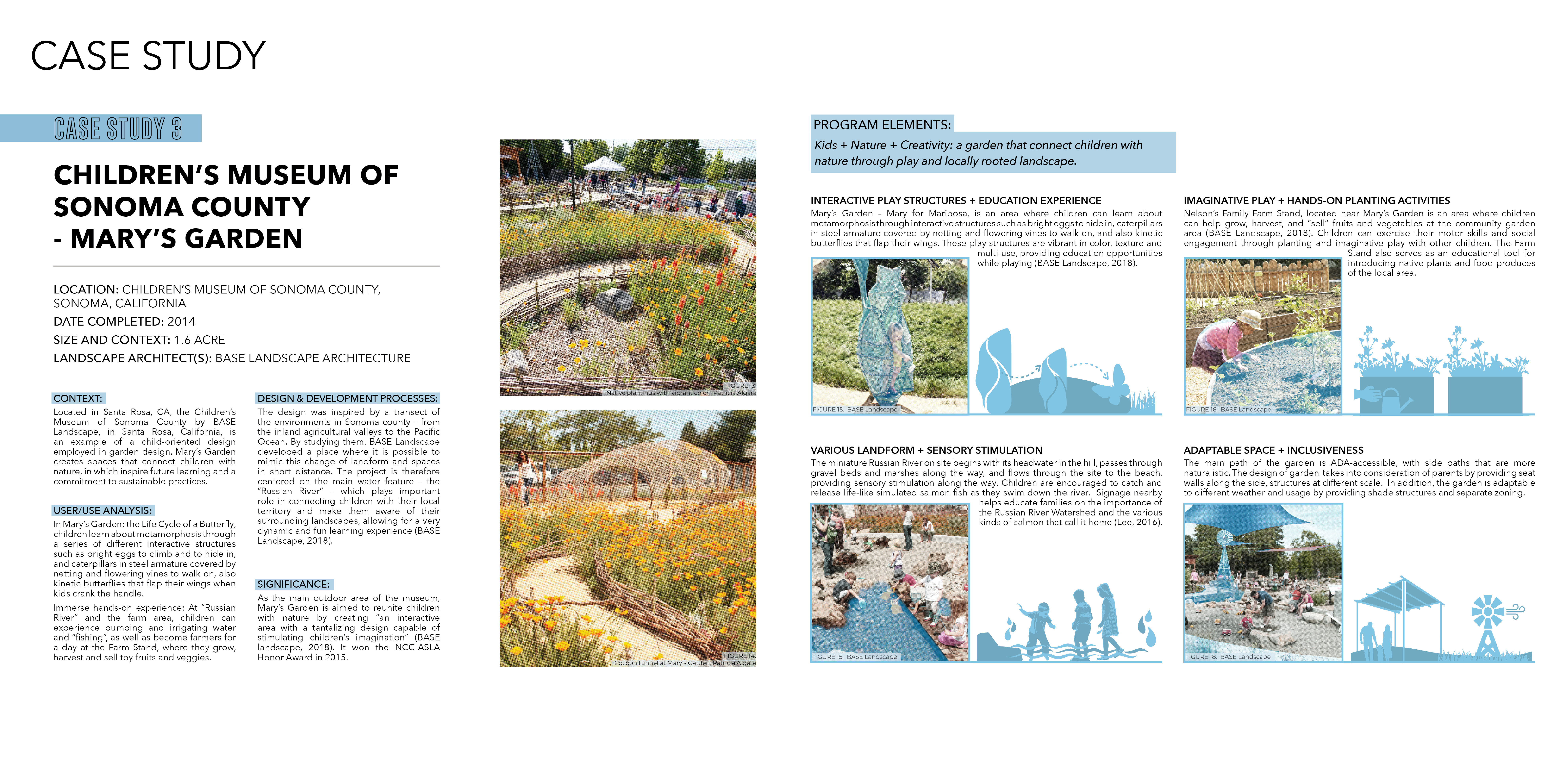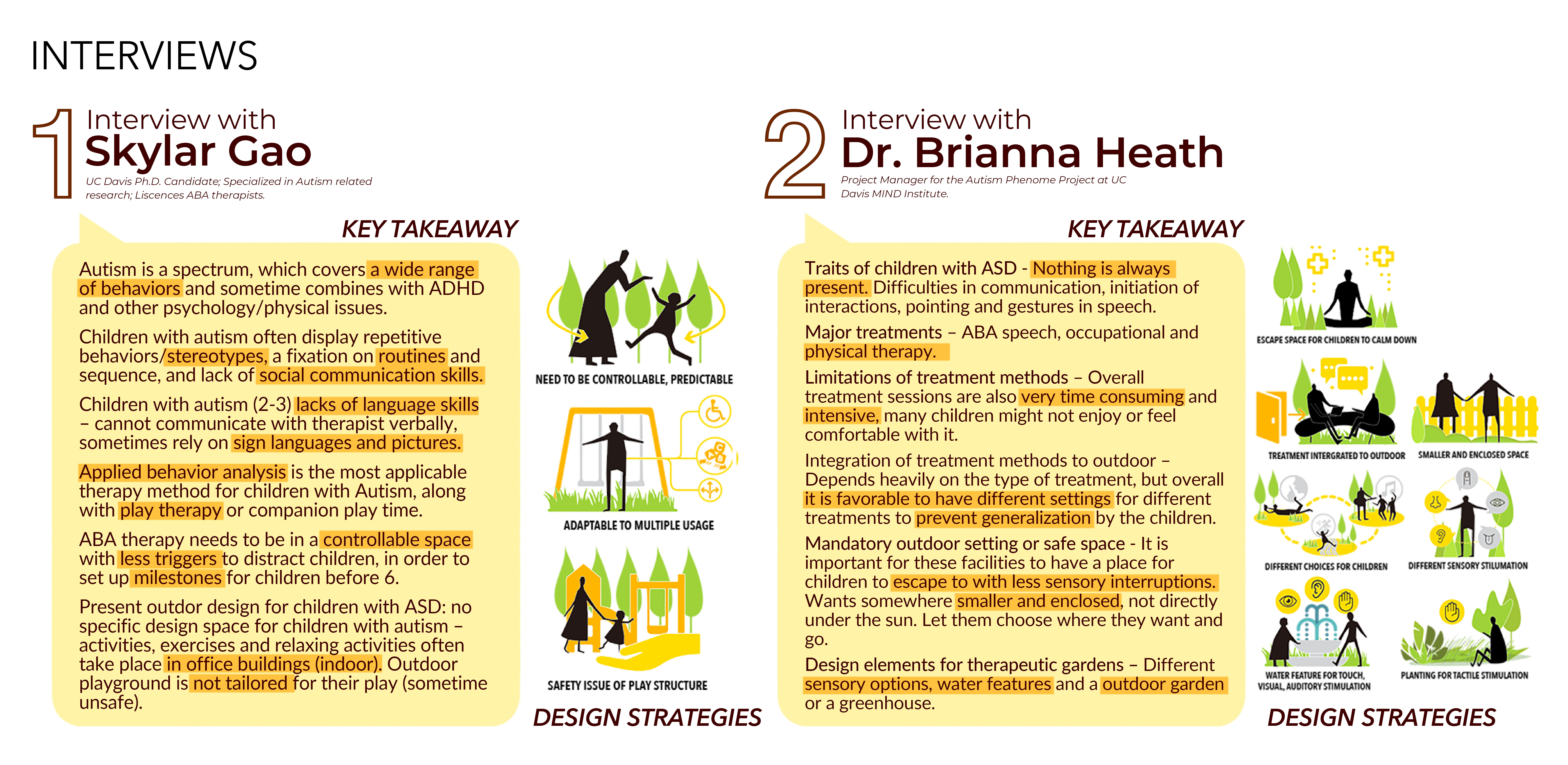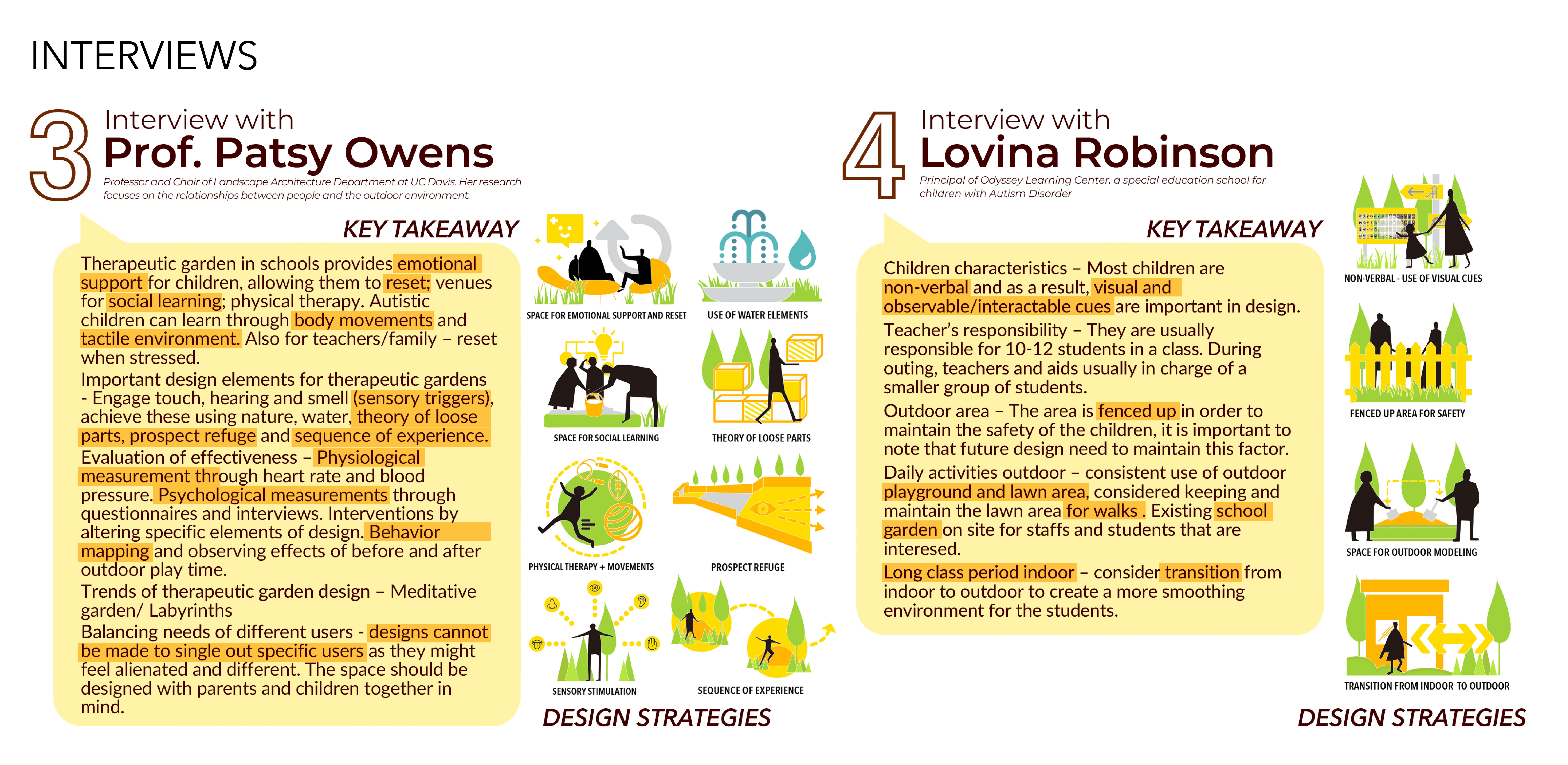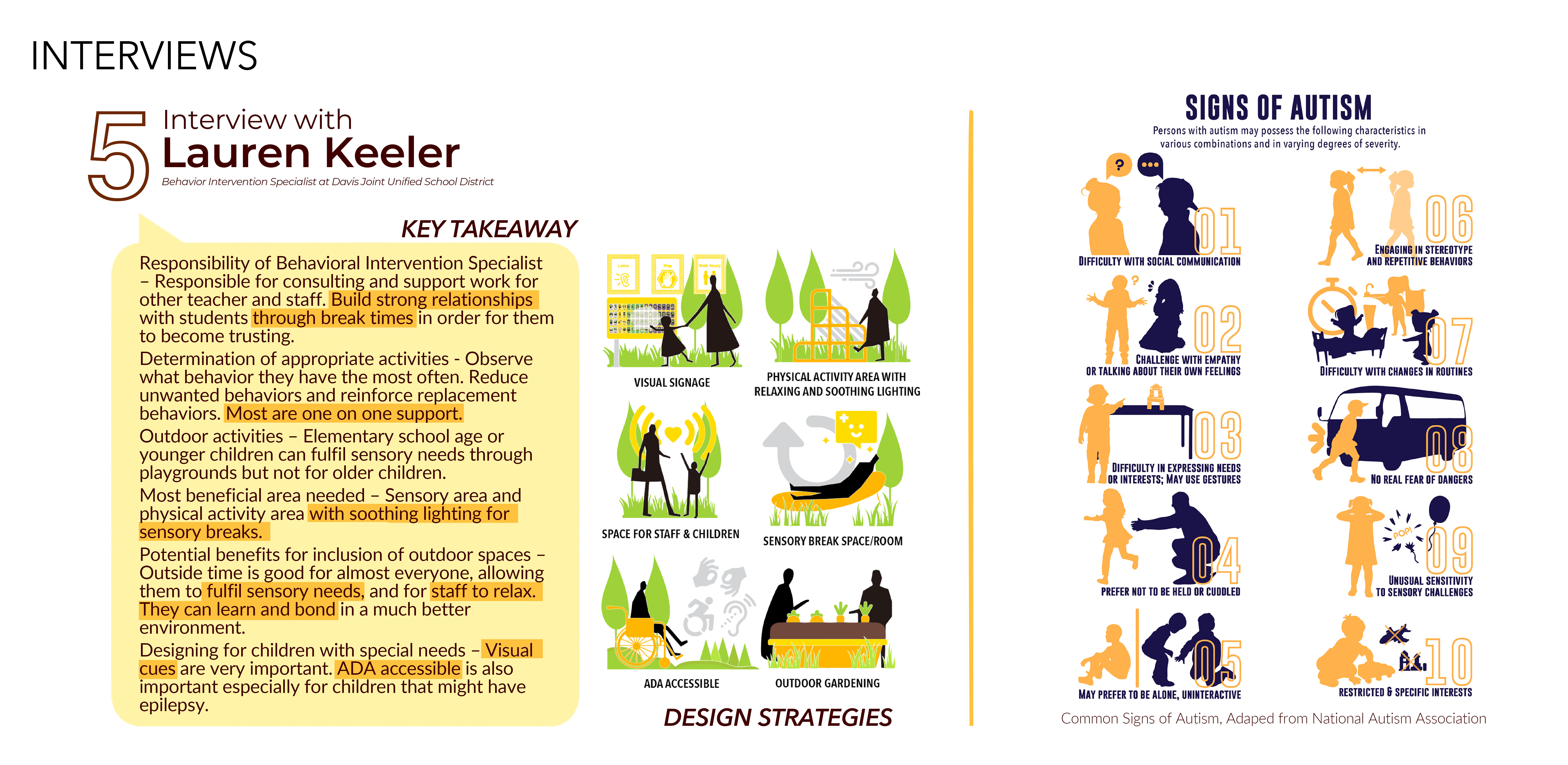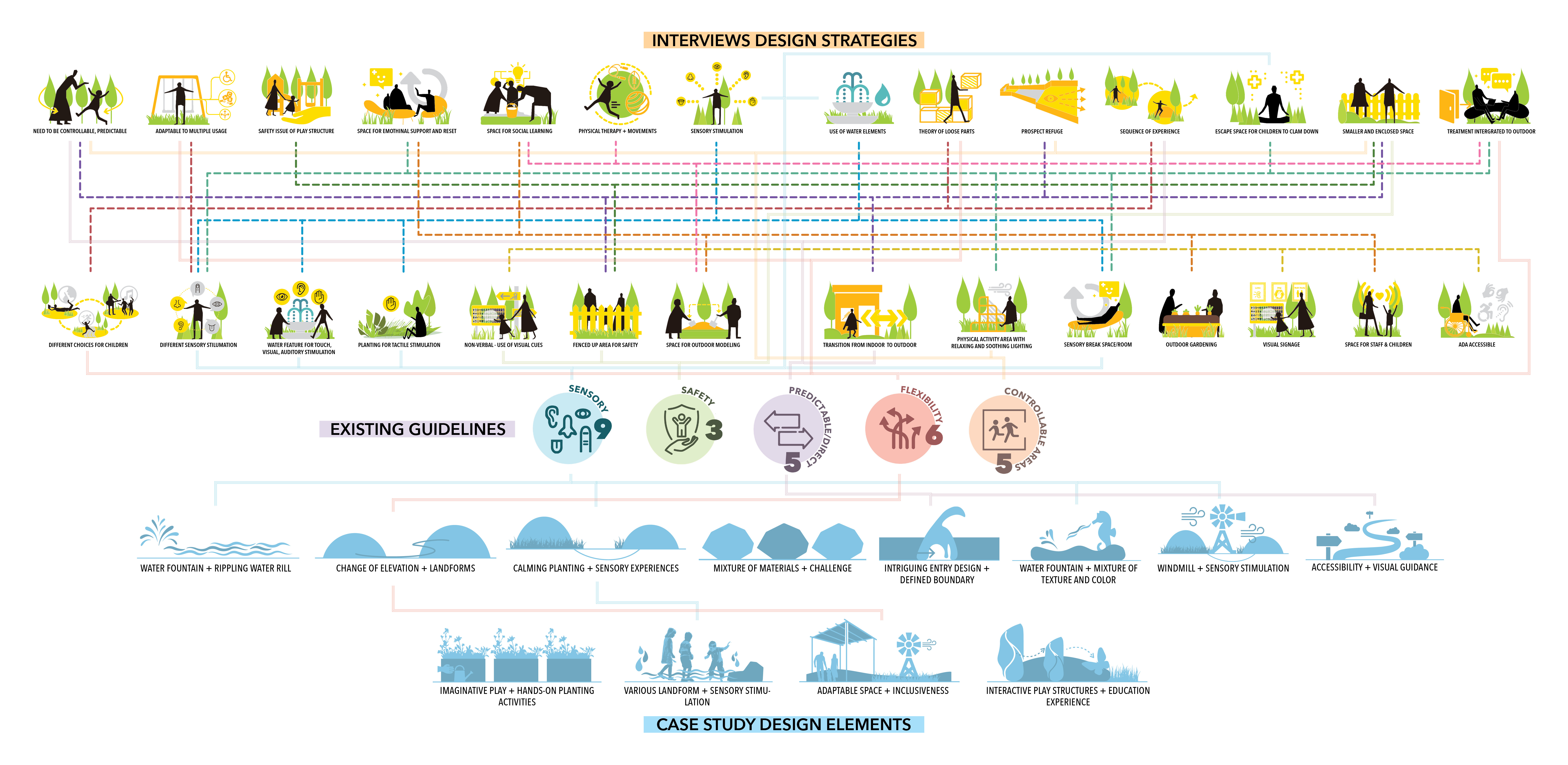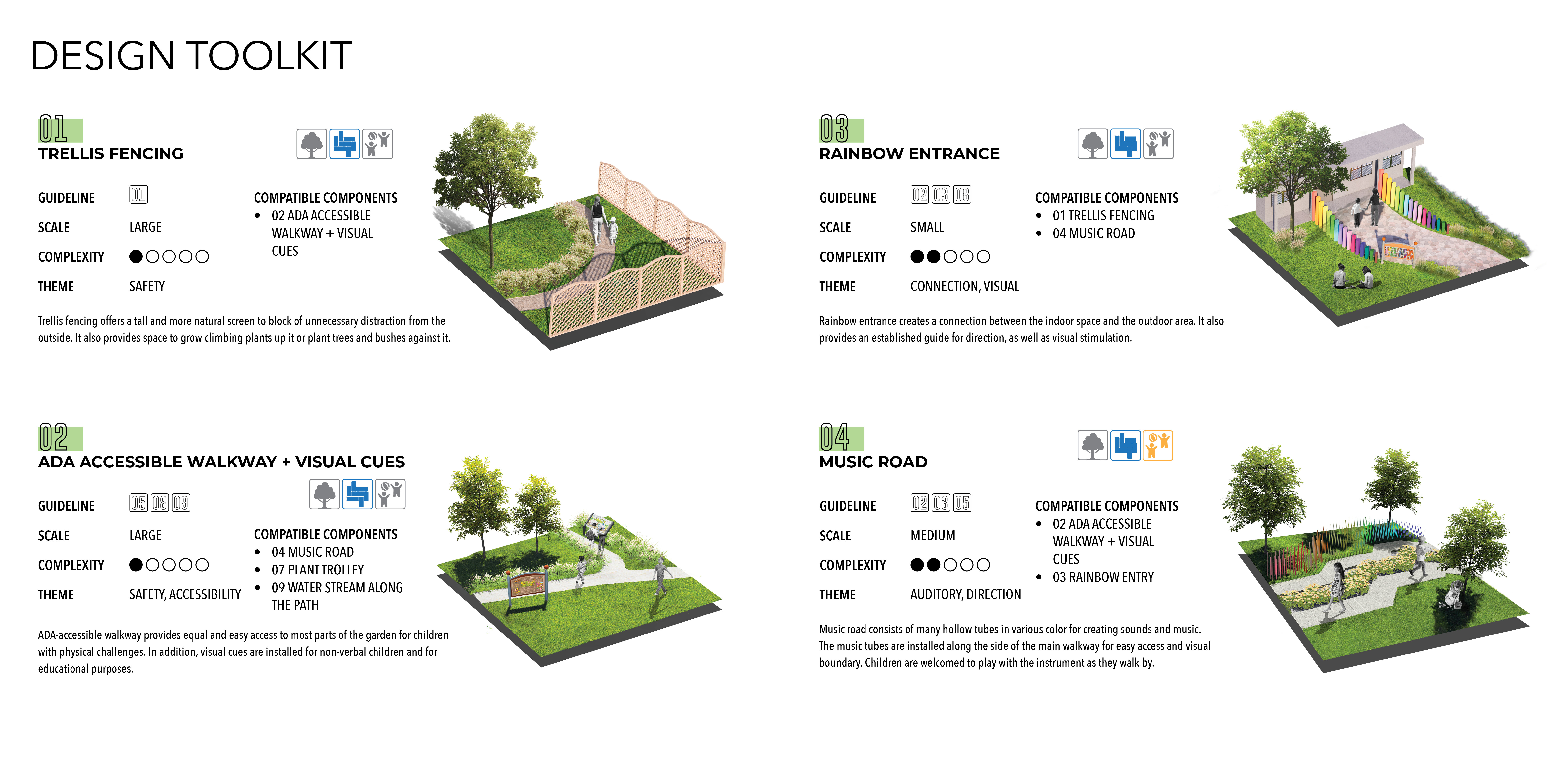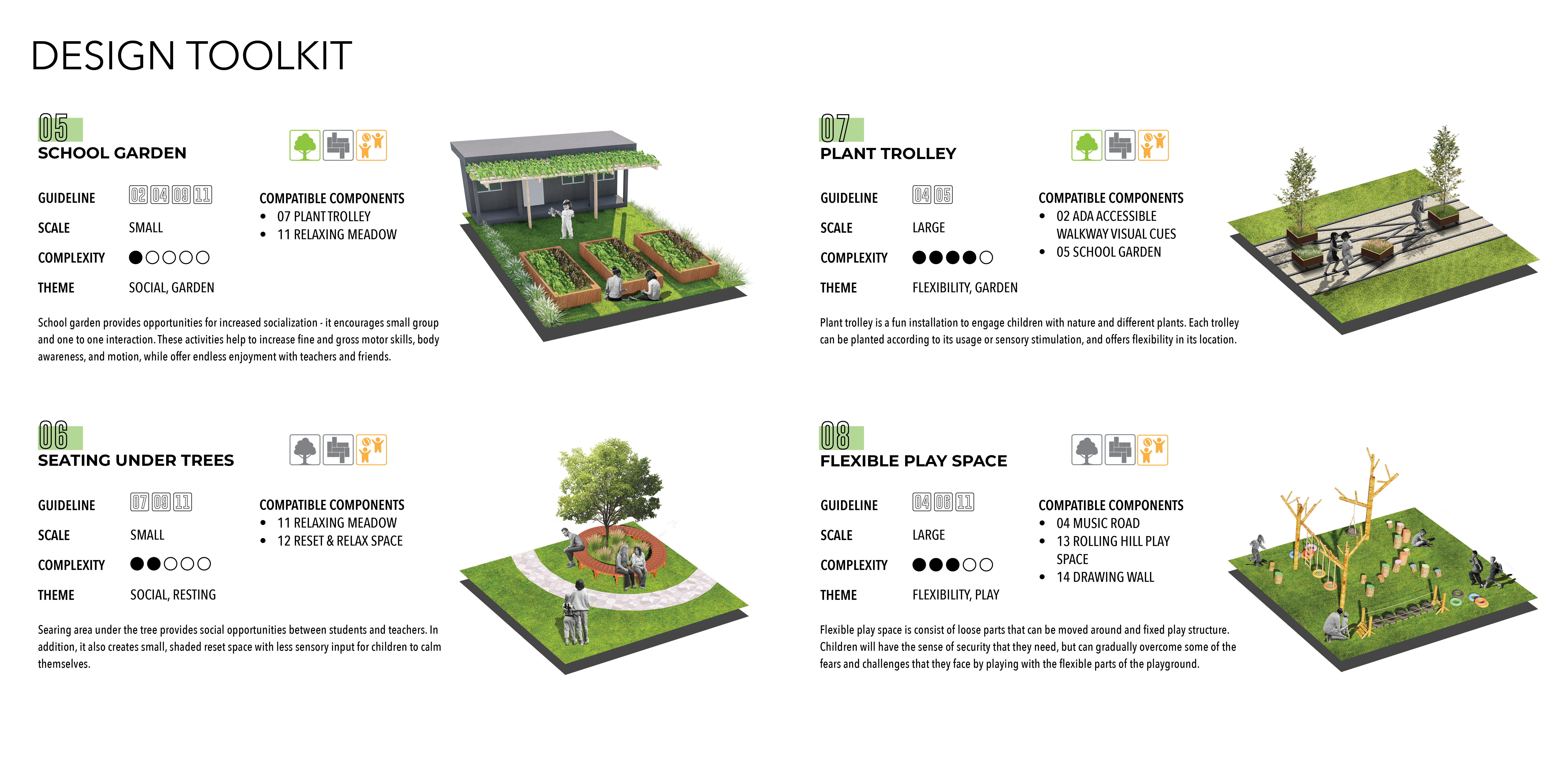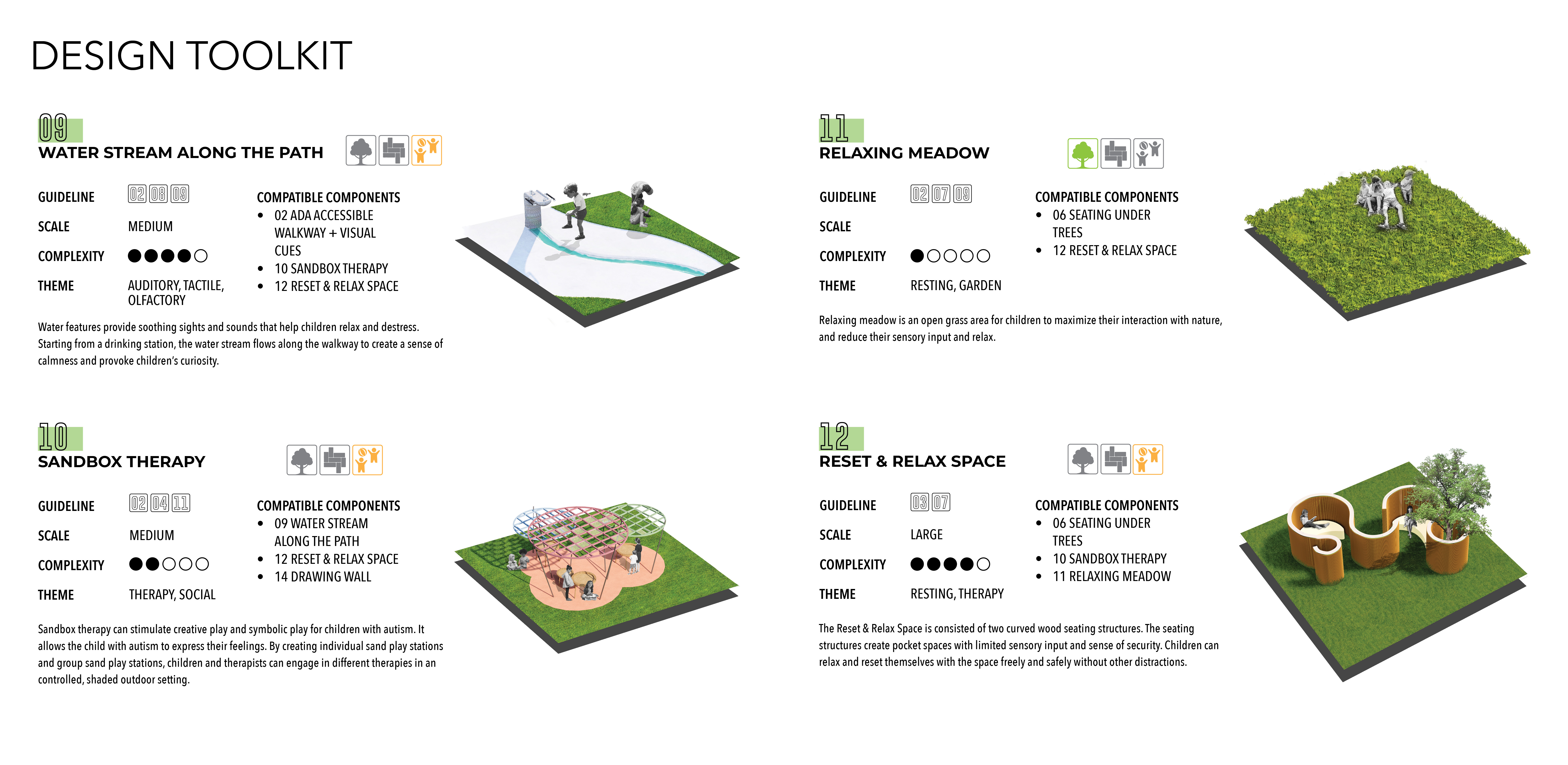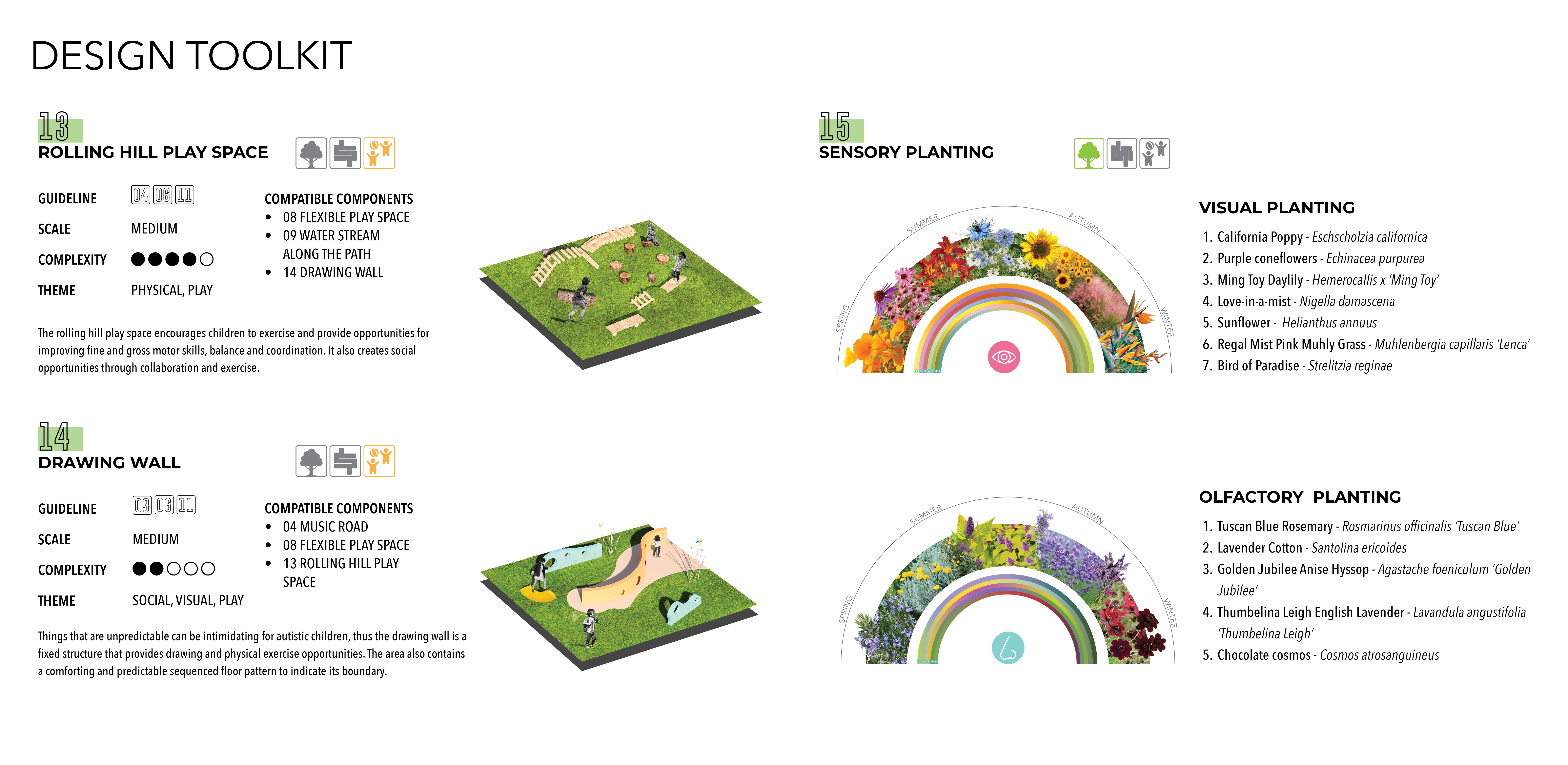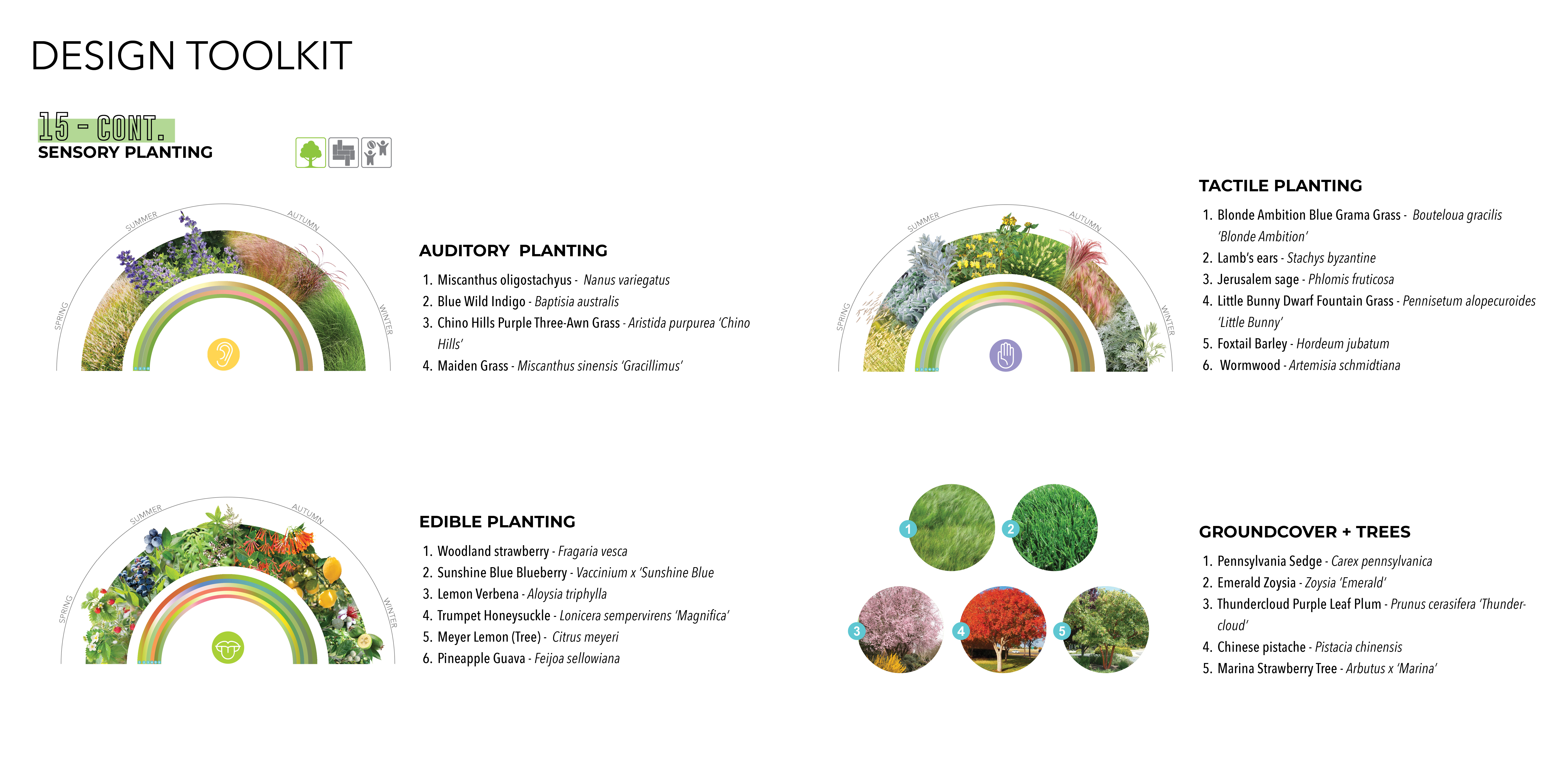Learn, Play, Thrive—Design Guidelines and Toolkit of Therapeutic Gardens for Children with Autism Spectrum Disorder
Honor Award
Research
Wenxi Huang, Student ASLA
Faculty Advisors: Yiwei Huang
University of California, Davis
Therapeutic gardens have been proven to benefit children with autism, and this project provides case studies and a thorough toolkit that can guide landscape architects in how to design for these specific circumstances. The authors provide a toolkit of fourteen design elements that are key to successful therapeutic gardens, including how to design spaces for personal withdrawal if sensory inputs become overwhelming. By designing safe, orderly gardens, the authors hope to create a framework for practitioners working across a range of healing landscapes.
- 2020 Awards Jury
Project Credits
Consultant
Yiwei Huang
Interviewee
Skylar Gao
Interviewee
Dr. Brianna Heath
Interviewee
Prof. Patsy Owens
Interviewee
Lauren Keeler
Interviewee
Lovina Robinson
Project Statement
This research project focuses on establishing an effective guideline or toolkit for landscape architects to design therapeutic gardens essential for autism and special education communities. The study investigates and identifies crucial design elements for a therapeutic garden through case studies of pre-existing sites, interviews with their staff and educators. Furthermore, literary reviews of academic articles highlighting the effectiveness of therapeutic gardens, supporting psychological theories, and examples of key elements had also been thoroughly reviewed.
Findings suggest that there are indeed clear benefits of therapeutic landscapes on the treatment and healing of children troubled by autism and other mental health issues. In addition, there are specific and clear elements that are essential and shared between these gardens, as a result guidelines and toolkits can be easily compiled and improve the efficiency of therapeutic garden designs.
Establishing a clear guideline and toolkit will benefit every autistic child and the people around them. With such resources, therapeutic gardens will likely become more abundant in the future, helping many other communities affected by mental health issues.
Project Narrative
Background:
With an increase in the prevalence of mental health issues, a need for therapeutic gardens is on a gradual increase. As a landscape architecture student, I am interested in this category and looking forward to explore and contribute towards its further development. My focus group for the research is young children with autism -- since the effectiveness of treatments and therapies rely heavily on the starting age of children, an earlier intervention will benefit them more and hence improve their overall conditions in the long run.
The main motivation behind my project is due to my discovery of the ratio of children with and without autism throughout the United States of America. Autism was found to be affecting 1 in every 150 children and the number is on the rise (American Psychiatric Association, 1994). Furthermore, autism being on a spectrum makes it a very difficult issue to resolve for different individuals; the only solution currently seems to be alleviating symptoms through play-based therapies and ample support from family members.
Theoretical Framework:
To begin the process of designing a therapeutic landscape for autistic children, it is important to first investigate the current, ever-broadening collection of literature on healing gardens.
Primarily, the biophilia hypothesis (BET), introduced and popularized by Edward O. Wilson’s Biophilia, suggests that humans possess an “innate tendency to seek connections with nature and other forms of life”. (1984).
Secondly, Steve and Rachel Kaplan’s work on "restorative environments" and Attention Restoration Theory influenced how many professionals view humanity's relationship with nature. Stephen and Rachel Kaplan (1989) proposed that there are four cognitive states, or states of attention, along the way to restoration: Clearer head, or concentration; Mental fatigue recovery; Soft fascination, or interest; Reflection and restoration (Kaplans, 1989).
In addition to the Attention Restoration Theory, Roger S. Ulrich also suggested the Stress Reduction Theory (SRT) to explain emotional and physiological reactions to natural spaces. His research suggested that outdoor visual environments can influence individuals’ psychological well-being, and therefore should be given explicit attention in planning and design decisions (Ulrich, 1981).
Research Methods:
To better understand the design and integration of key elements in a therapeutic garden, several research had also been conducted through different methods.
Through the case studies of three existing therapeutic gardens, the Institute for Child and Adolescent Development, the Leichtag Family Healing Garden at Children’s Hospital and Health Center as well as Mary’s Garden of the Children’s Museum of Sonoma County, I analyzed and compiled a list of important design elements that are shared across the sites. The case studies also gave me a clearer picture of what a therapeutic garden needs to be like and how to achieve designing one.
In my literature reviews, I came across evidence for the effectiveness of therapeutic gardens on not only improving the mental health and conditions of autistic individuals but also the general public too. These scientific articles also provided examples, which contributed to the completion of my therapeutic garden design guideline and toolkit.
My interviews with two professionals from the UC Davis MIND Institute, a UC Davis Landscape Architecture professor and two special education teachers provided me with more insight on the issue of autism itself, several design elements that are crucial to designing an effective therapeutic garden and the state and abundance of these gardens around the country.
Completed Guideline and Toolkit:
Compiling the data and information acquired from my research, I was able to come up with a list of preliminary therapeutic garden design guidelines and toolkit. These are in my opinion truly essential components to create safe and efficient therapeutic gardens for children with autism.
The guidelines are as follows:
1. Safety and Security:
Children with autism are often curious and sometimes unwilling to follow orders. It is important to have an enclosed therapeutic garden to keep the children from wandering off, and to enable the staff and administrators to monitor/secure the children during an outdoor play session.
2. Sensory Integration Activities:
Children with ASD are often less responsive to sensory stimuli than neurotypical children (Kern et al. 2008), therefore strong multi-sensory landmarks and activities that will attract the shared attention of all children will greatly benefit them. Multisensory stimuli stimulate or soothe the visual, tactile, olfactory, and auditory of children.
3. Clear Physical Structure:
A child will feel an increased sense of control and emotional security when they can traverse and be guided through an environment easily. The design of a therapeutic garden must be clear, orderly, and structured. Organize environment with clear visual and physical boundaries. Avoid ambiguity and elements that might confuse and frustrate the child. This will help create a definite context for each activity in association with a given space. The layout should provide a clear image for the children to determine where to go, how to get there, and what to do easily.
4. Flexibility in Space Arrangement and Structure Design:
Flexible environment to accommodate a wide range of functional skills and different teaching paradigms. The space should allow for changes without costly or time-consuming renovations. Provide spaces and structures with loose parts for sensory play including manipulation and social expression.
5. Visual Cues for Direction and Instructions:
Children with ASD face challenges in social settings, due to trouble with communication, limited interests, or repetitive behaviors. Visual cues and instructions would help them to communicate better and follow directions. It also indicates the sequence to be followed when performing certain activities by means of not only written guidance, but also images, pictures, and visual schedules, etc.
6. Opportunity for Proprioceptive Activities to Stimulate Children’s Motor Skills and Relieve Stress:
Children with autism might experience stress, sadness, and other negative feelings throughout the day, thus it’s important to create an outlet for these emotions in the outdoor area. The therapeutic garden could provide physical outlets for releasing their unwanted feelings.
7. Withdrawal Spaces:
Controlling sensory input and avoiding sensory overload are important goals of many therapeutic programs for children with autism. A private withdrawal space where the children can take a “sensory break” to get away and reset themselves through spatial arrangement is essential.
8. Maximize Accessibility of the Space:
The therapeutic garden should be accessible to all children through ADA-accessible design and route arrangements. Impairments in movement coordination and balance, epilepsy, restricted attention span, and other difficulties might cause children with ASD to encounter physical challenges in an outdoor environment.
9. Provide Interactions with Nature:
The therapeutic garden should provide opportunities for children to experience nature. Appropriate and stimulating plants will allow for hands-on experience and observable seasonal changes through colors.
10. Design for Easy Maintenance:
Therapeutic gardens should ultimately remain low maintenance in order to maximize its efficiency. The cost of upkeeping will be low and at the same time could be integrated into a part of activity for the children, such as watering and learning about the care of plants.
11. Social Space:
An effective therapeutic garden also has to include a space to encourage social interactions. A social space will not only benefit the children but also allow staff members and parents to interact with each other.
From these guidelines, a toolkit with 14 design elements has also been created. These elements are showcased in the attached images, portraying how each element can be utilized and combined. As previously mentioned, these are mostly preliminary ideas, even though it is already comprehensive, improvements can definitely be made for it to cater to the needs of other groups. I hope that my efforts will be a stepping-stone towards the commodification of therapeutic gardens in the landscape architect community, pushing for better and more efficient designs.
